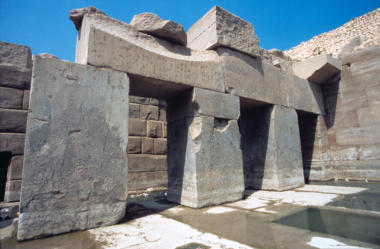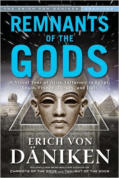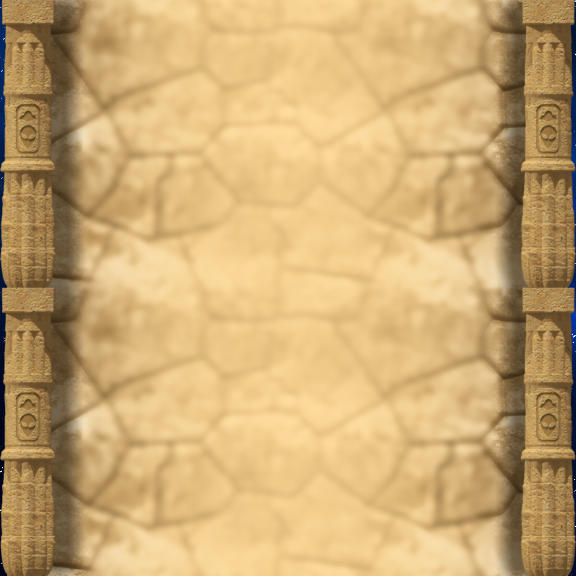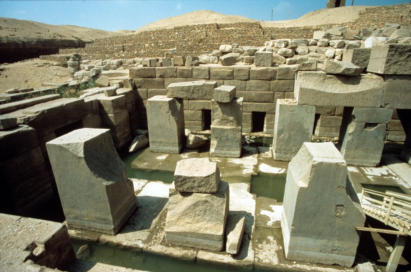





































Megaliths and Stone Constructions
Abydos – oldest megalithic construction of Egypt?
Abydos
lies
561
kilometers
south
of
Cairo,
directly
on
the
Nile.
The
Egyptians
of
the
Old
Kingdom
(2600-2200
BC)
were
already
doing
ar-chaeology
there:
"They
turned
over
the
ground."
What
they
were
looking
for
at
that
time
is
just
as
unknown
as
the
origins
of
Abydos.
Today
it
is
the
temples
of
Sethos
I
(1294-1279
BC)
and
his
son
Ramses
II
(1279-1213
BC)
that
dominate
the
scene.
But
the
temple
complex
of
Sethos
I
partially
rests
on
foundations
from
those
mythical
times
of
which
we
know
nothing.
Directly
behind
the
temple
there
is
the
so-called
Osireion,
a
complex
constructed
from
giant
granite
blocks
which,
looked
at
from
a
technological
perspective,
does
not
fit
in
with
the
Sethos
temple, whichever way you look at it.
As
long
ago
as
1726,
when
no
official
department
of
archaeology
yet
existed,
the
Frenchman
Granger
(real
name
Tourtechot)
started
digging
in
Abydos.
At
that
time,
the
whole
complex
lay
under
the
desert
sands
and
only
a
few
upright
columns
signaled
a
structure
under
the
surface.
The
next
Frenchman
to
burrow
in
Abydos,
Emile
Amelineau,
discovered
tombs
from
the
First
and
Second
Dynasty,
about
5,000
years
in
the
past
when
calculated
from
today.
In
1859,
when
Abydos
had
been
buried
by
the
desert
again,
Auguste
Mariette,
the
subsequent
founder
of
the
Egyptian
Museum
in
Cairo,
had
Abydos
shoveled
free
again.
Eventually
the
Britons
Sir
Flinders
Petrie
and
Margaret
Murray
undertook
research
in
Abydos
in
1903,
and
in
1912,
the
famous
Swiss
Egyptologist
Professor
Edouard
Naville
(1844-1926)
discovered
a
granite
stone
gateway
in
the
ground
with
various
subterranean
chambers.
Naville
investigated
the
up
to
100-tonne
granite
blocks
of
the
Osireion
and
finally
concluded
with
resignation
that
this
complex
had
to
be
considered
as
the
"oldest
structure
in
the
whole of Egypt."
The
Osireion
lies
15
meters
below
the
level
of
the
temple
of
Sethos
I
and
consists
of
massive
granite
blocks
without
any
ornamentation
-
comparable
with
the
megaliths
of
Stonehenge
in
southern
England.
Why
is
the
complex
called
"Osireion"?
Because
according
to
legend,
the
head
of
the
heavenly
god
Osiris
is
said
to
be
hidden
there.
Osiris
is
equivalent
to
Orion.
He
originally
came
from
that
constellation.
He
studied
humans,
taught
them,
and
was-similar
to
the
Greek
Apollo
and
Peruvian
Viracocha
a
helpful
god.
It
was
Osiris
who
traveled
throughout
the
world
and
taught
human
beings
agriculture,
respect
for
one
another,
and,
particularly,
the
magic
power
of
music
and
song.
But
Osiris
had
a
jealous
brother,
Seth.
He
wanted
the
earth
and
all
its
people
for
himself,
and
so
he
treacherously
murdered
his
brother,
Osiris.
In
order
to
prevent
him
ever
coming
back
to
life,
Seth
cut
up
the
body
of
Osiris
into
14
pieces
and
buried
the
different
parts
of
the
body
in
different
places
-
the
backbone
in
Busiris,
a
leg
in
Philae,
the
phallus
in
Mendes,
and
the
most
important
part
of
the
body,
the
head,
in
Abydos
-
hence
"the
Osireion."
The
head
of
the
god
Osiris
has
not
been
found
in
Abydos
to
the
present
day.
And
that
is
unlikely
to
change,
because
Osiris,
like
his
mystical
companions,
belongs
to
the
clan
of
the
extraterrestrials.
They
are
reported
about
in
the
so-called
Pyramid
Texts
from
the
Fifth
and
Sixth
Dynasty,
whereby
it
remains
an
open
question
how
long
the
texts
were
already
in
existence
before
someone
chiselled
them
into
the
granite.
These
texts
are
full
of
gods
who
descend
to
earth
from
the
heavens,
and
of
pharaohs
who
were
accorded
the
honor
of
visiting
the
world
of
the
gods.
As
the
confused
spirit
of
our
times
only
sees
abstract
thinking
behind
the
Pyramid
Texts,
our
gullible
academics
from
the
last
century
conjured
wishful
thinking
and
dreams
of
the
priests into these texts or the journey of the pharaoh after death.
Source:
Remnants
of
the
Gods,
page
111














































Megaliths and Stone
Constructions
Abydos – oldest megalithic construction of
Egypt?
Abydos
lies
561
kilometers
south
of
Cairo,
directly
on
the
Nile.
The
Egyptians
of
the
Old
Kingdom
(2600-2200
BC)
were
already
doing
ar-chaeology
there:
"They
turned
over
the
ground."
What
they
were
looking
for
at
that
time
is
just
as
unknown
as
the
origins
of
Abydos.
Today
it
is
the
temples
of
Sethos
I
(1294-1279
BC)
and
his
son
Ramses
II
(1279-1213
BC)
that
dominate
the
scene.
But
the
temple
complex
of
Sethos
I
partially
rests
on
foundations
from
those
mythical
times
of
which
we
know
nothing.
Directly
behind
the
temple
there
is
the
so-called
Osireion,
a
complex
constructed
from
giant
granite
blocks
which,
looked
at
from
a
technological
perspective,
does
not
fit
in
with
the
Sethos temple, whichever way you look at it.
As
long
ago
as
1726,
when
no
official
department
of
archaeology
yet
existed,
the
Frenchman
Granger
(real
name
Tourtechot)
started
digging
in
Abydos.
At
that
time,
the
whole
complex
lay
under
the
desert
sands
and
only
a
few
upright
columns
signaled
a
structure
under
the
surface.
The
next
Frenchman
to
burrow
in
Abydos,
Emile
Amelineau,
discovered
tombs
from
the
First
and
Second
Dynasty,
about
5,000
years
in
the
past
when
calculated
from
today.
In
1859,
when
Abydos
had
been
buried
by
the
desert
again,
Auguste
Mariette,
the
subsequent
founder
of
the
Egyptian
Museum
in
Cairo,
had
Abydos
shoveled
free
again.
Eventually
the
Britons
Sir
Flinders
Petrie
and
Margaret
Murray
undertook
research
in
Abydos
in
1903,
and
in
1912,
the
famous
Swiss
Egyptologist
Professor
Edouard
Naville
(1844-1926)
discovered
a
granite
stone
gateway
in
the
ground
with
various
subterranean
chambers.
Naville
investigated
the
up
to
lOO-tonne
granite
blocks
of
the
Osireion
and
finally
concluded
with
resignation
that
this
complex
had
to
be
considered
as
the
"oldest
structure
in
the
whole of Egypt."
The
Osireion
lies
15
meters
below
the
level
of
the
temple
of
Sethos
I
and
consists
of
massive
granite
blocks
without
any
ornamentation
-
comparable
with
the
megaliths
of
Stonehenge
in
southern
England.
Why
is
the
complex
called
"Osireion"?
Because
according
to
legend,
the
head
of
the
heavenly
god
Osiris
is
said
to
be
hidden
there.
Osiris
is
equivalent
to
Orion.
He
originally
came
from
that
constellation.
He
studied
humans,
taught
them,
and
was-similar
to
the
Greek
Apollo
and
Peruvian
Viracocha
a
helpful
god.
It
was
Osiris
who
traveled
throughout
the
world
and
taught
human
beings
agriculture,
respect
for
one
another,
and,
particularly,
the
magic
power
of
music
and
song.
But
Osiris
had
a
jealous
brother,
Seth.
He
wanted
the
earth
and
all
its
people
for
himself,
and
so
he
treacherously
murdered
his
brother,
Osiris.
In
order
to
prevent
him
ever
coming
back
to
life,
Seth
cut
up
the
body
of
Osiris
into
14
pieces
and
buried
the
different
parts
of
the
body
in
different
places
-
the
backbone
in
Busiris,
a
leg
in
Philae,
the
phallus
in
Mendes,
and
the
most
important
part
of
the
body,
the
head,
in
Abydos
-
hence
"the
Osireion."
The
head
of
the
god
Osiris
has
not
been
found
in
Abydos
to
the
present
day.
And
that
is
unlikely
to
change,
because
Osiris,
like
his
mystical
companions,
belongs
to
the
clan
of
the
extraterrestrials.
They
are
reported
about
in
the
so-
called
Pyramid
Texts
from
the
Fifth
and
Sixth
Dynasty,
whereby
it
remains
an
open
question
how
long
the
texts
were
already
in
existence
before
someone
chiselled
them
into
the
granite.
These
texts
are
full
of
gods
who
descend
to
earth
from
the
heavens,
and
of
pharaohs
who
were
accorded
the
honor
of
visiting
the
world
of
the
gods.
As
the
confused
spirit
of
our
times
only
sees
abstract
thinking
behind
the
Pyramid
Texts,
our
gullible
academics
from
the
last
century
conjured
wishful
thinking
and
dreams
of
the
priests
into
these
texts
or the journey of the pharaoh after death.
Source:
Remnants
of
the
Gods,
page 111








